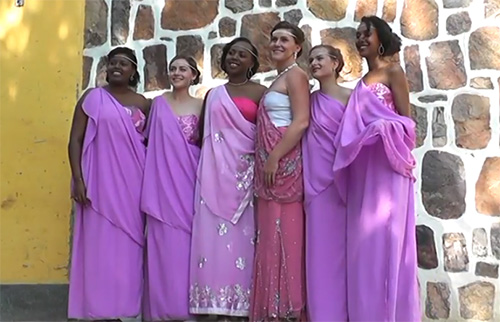 In several African countries, women wear a beautiful flowing outfit called “mushanana”. At first glance, it may look like the fabric is a little carelessly thrown over the body, but it isn’t like that. Women in Africa just need some thin and flowing layers of cloth to protect their skin from the hot sun. And this attire is perfect – formal enough to be worn for any occasion, festive, flattering, and comfortable at the same time. This outfit is mostly popular among the women of Rwanda, Uganda, and Burundi.
In several African countries, women wear a beautiful flowing outfit called “mushanana”. At first glance, it may look like the fabric is a little carelessly thrown over the body, but it isn’t like that. Women in Africa just need some thin and flowing layers of cloth to protect their skin from the hot sun. And this attire is perfect – formal enough to be worn for any occasion, festive, flattering, and comfortable at the same time. This outfit is mostly popular among the women of Rwanda, Uganda, and Burundi.
This flowing and cute female outfit is called “mushanana”. It consists of 3 separate pieces: a long wrap-around skirt, a tight-fitting top or bustier, and a short piece of cloth that loosely hangs over one shoulder.
Like many African traditional garments, this costume is sewn from thin, airy, and light fabrics that breathe easily but cover a lot of the body. The fabric usually has some African print to finish the look. It can be really colorful and bright.
A mushanana can be complemented with some African traditional beaded jewelry. For example, a beaded necklace in the same colors as the dress. But it shouldn’t be too multicolored, otherwise, the appearance looks a bit tacky.

The typical hairdo worn with a mushanana is a bun. You can wear your hair loose as well. Often, a ribbon is worn around the forehead, like a headband. Brides wear a ribbon of a specific shape, adorned with gems, pearls, etc. The style of a headband depends on the occasion.
Today, mushanana is seldom worn by African women in daily life. But this is the costume of choice for various festive and ceremonial occasions, particularly in Rwanda, Uganda, and Burundi. This attire can be worn by a bride, bridesmaid, woman who goes to an official party or reception, etc. Also, it is worn for a church service, funeral, and other similar official events. Rwandan, Ugandan, and Burundian folk dancers use this attire as well. Luckily, mushanana as a ceremonial dress is still rather popular in Africa and this tradition is still alive.


